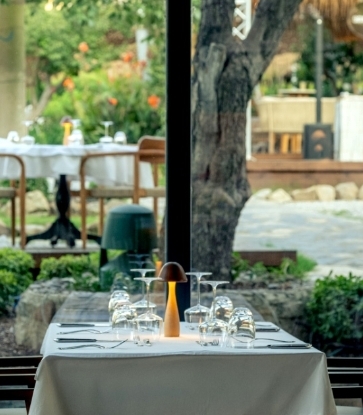The relentlessly rainy mid-Atlantic weather in 2018 didn't do any favors for farmers. Everything from summer's watermelon crops to fall's pumpkin harvest were compromised thanks to the record rainfall.
But there's one type of food harvesters who are having a field day: mushroom foragers. Over a dinner starring a luscious wild mushroom bruschetta and a fungi-sauced pasta made with flour from foraged acorns, Evening Star Café chef Jonathan Till revealed that all the pesky moisture culminated in a bumper crop of mushrooms and an extended season.
"In this area, we got a record amount of rain, and anywhere you get rain you're going to get fungus," says Till, whose restaurant is located in Alexandria, Virginia. "The farmers hated the weather, but it was probably one of the best mushroom years I'll ever see in my life. Mushrooms [normally] fruit maybe twice a year, [and] we got maybe four or five fruitings [last season]."
The weird mushroom season resulted in varieties that don't normally overlap appearing simultaneously, such as the maitakes and black trumpets he found growing side-by-side. "Usually, the maitakes are a late-season mushroom," he explains. "Black trumpets will come up, and the maitakes usually come in after they die."
The wet weather not only affected the length of the season but also the sheer volume of fungi, according to Till.
"Chanterelles typically come up late June [or] early July in this area, and they go to maybe August [or even] October if it's a good year," he says. "This year, they just kept coming and coming and coming. They were everywhere."
The record rainfall combined with the mild winter has resulted in mushrooms still growing in early February in the Virginia forests where the chef likes to forage. Throughout the year, he has found four types of chanterelles—including black trumpets, which are a member of that family—along with hedgehog, cauliflower, several varieties of oyster, puffballs, hen of the woods, chicken of the woods, old man of the woods, blewits and jelly ear mushrooms, which the chef likes to pickle.
Till, who grew up in both upstate New York and Louisiana, says he learned to forage when he returned to upstate New York after culinary school. There, his friends told him about a trapper who could help him in his quest to learn about foraging—a hobby he wanted to cultivate in an effort to set himself apart from other culinary school grads.
"For two years, he'd take me out in the woods and show me plants and mushrooms," Till says. "He was a huge inspiration and definitely my first mentor when it comes to finding mushrooms in the woods."
Before he took over the kitchen at Evening Star Café last fall, Till spent time over the summer foraging for mushrooms in Europe, including his wife's native Slovakia, where his foraging father-in-law taught him how to find European mushrooms. When he returned, he staged at Washington, D.C.'s The Dabney, which boasts a Michelin star. After chef Jeremiah Langhorne found out Till was an avid forager, Till soon started sharing his oyster mushroom finds with The Dabney's kitchen.
The chef, who also foraged 30 or so pounds of acorns last fall that he made into flour for pasta, recently struck up a relationship with folks from Monticello, Thomas Jefferson's Charlottesville plantation. Till reckons it's been about 100 years since anyone has foraged on that land, and he's excited to see what's out there.
"You're taught from a young age to be careful and not eat mushrooms that you find in the woods," he says, noting that most people in Slovakia know how to forage. "It has almost a mystique to it, almost taboo. To be able to go in the woods and say, 'That's edible,' that's really cool."
Till says that while it's absolutely doable with practice and truly rewarding, it's not something you want to enter into casually. Eating the wrong mushrooms can result in some pretty serious issues, including liver failure. Till also cautions that if you find it in your yard, it's probably poisonous.
"I would definitely find a group, find somebody who knows what they're doing and will take you out or at least bring samples of what you should look for," he advises. "[New foragers] should also . . . buy all the books they can."
Meanwhile, if this year's weather so far is any indication, we might be in for another banner season for fungi growth.
"If it continues to be as wet as it is, it's going to be another good year. There are shoots coming out right now, so it's very possible that if we get some good weather a couple weeks in a row, morels might pop up early."



















